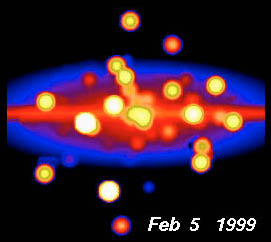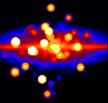RXTE Discoveries
RXTE Captures the Ongoing Light Show at the Galactic Center - June 1999
|
June is a month known for fireflies - they blink on and off giving us a show of lights.
|  |
 |
Far beyond Earth, near the center of our Galaxy, is a different kind of light show. RXTE captured images of a couple dozen stars blinking on and off like our earth-bound fireflies, as they give off random flares of X-rays and then disappear. Some of these flares last only a few minutes, and other last for months.
|
Twice weekly, since February 1999, Dr. Craig Markwardt and other researchers of the Goddard Space Flight Center have been scanning the galactic center region with RXTE, looking for an elusive type of pulsar.
The first and only such pulsar, designated SAX J1808.4-3658, was discovered in April of 1998, providing evidence for the theory that suggests a missing evolutionary link between old isolated millisecond pulsars and slower-spinning pulsars in binary (two-star) systems. Dr. Markwardt and other researchers suspect that other similar pulsars may exist in the same region where the first one was found. Says Dr. Markwardt, "We are farming for black holes and neutron stars near the Milky Way galactic center. That area is such a fertile ground for our search because the center of the Galaxy has the highest concentration of stars and gas, the ingredients needed to make black holes and neutron stars." He adds this analogy, "If you want to see the lights, you head downtown. Just like a city glows brightest downtown, the galactic center has the highest concentration of stars. So it's here that we have the best chance of finding a millisecond X-ray pulsar."
Markwardt has not yet found the pulsar he's looking for, but he did happen upon seven new highly variable X-ray sources. These are sources that may increase as much as tenfold in X-ray luminosity, but then fade out in anywhere from minutes to days. Along with these seven new sources, Markwardt and RXTE caught 31 other sources as they flickered in and out. At least 21 of these sources (out of 38 total) are thought to be neutron stars; four others are possible black hole systems. Twelve of the other X-ray sources in this "census" are unclassified, though four of them belong to the group of high variable sources Markwardt discovered.
|
This census of stars, along with a 20 second, time-elapsed movie of these sources, was presented in early June at the Centennial Meeting of the American Astronomical Society (AAS). With sensitive and regularly sampled images of the galactic center region, Markwardt was able to string individual observations into a time-elapsed movie that illustrates the irregular X-ray flare-ups of some star systems.
|  1.8 M Quicktime .mov |
The X-ray data depicted in this movie are measurements of bizarre behaviors at extreme gravity and temperature. The transient X-ray sources shown in the movie are almost as extreme as you can get - they are primarily compact objects like black holes and neutron stars, the core remains of massive stellar explosions. Most black holes and neutron stars exist in binary star systems, where they orbit more normal stars. Their extreme gravity pulls matter off the companion star, where it forms an orbiting disk around the collapsed star. As this gas orbits the black hole or neutron star it is pulled inward, where it is heated up to millions of degrees in temperature and emits X-rays.
The transient nature of the Markwardt's sources is due to the flow of this gas from the companion star to the black hole or neutron star. Markwardt says, "It's like the normal companion star has little indigestion and puffs up every once in a while, spilling matter into the black hole or neutron star." This fluctuating of the gas spilling onto the compact object is most likely what is causing the flickering of the X-ray radiation we see.
Says Dr. Jean Swank, co-investigator of this study, "One goal of X-ray astronomy is to better understand the binary systems that are X-ray transients. Dr. Markwardt's animation is a visualization of the firefly-like character of their X-ray brightness."
This galactic center scan is due to continue until March, 2000. Says Dr. Swank, "Our observations will monitor all the significant outbursts that occur in this year in the central region of our galaxy. We will be learning where they are and how often they are bright, and we will keep a close watch for special systems like SAX J1808.4-3658, which are hidden treasures."
(Firefly graphic by Paul Campagnoli)


